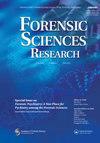Exploring Adult Age-at-Death Research in Anthropology: Bibliometric Mapping and Content Analysis
IF 1.4
4区 医学
Q3 MEDICINE, LEGAL
引用次数: 0
Abstract
Although there are known limited skeletal traits that can be used to estimate age-at-death, an increasing body of literature is addressing this topic. This is particularly true in journals dedicated to forensic anthropology and past population studies. Research has focused mostly on methodological developments, aiming to update and validate age-at-death methods’ accuracy, with recurrent formulation, reformulation, testing, and re-testing of classical methodological approaches in multiple populational datasets and using novel statistical approaches. This paper explores aging research in adults published over the last century, aiming to portray major research agendas and highlight main institutions and co-authorship networks. A comprehensive dataset of bibliometric data from 1225 publications on age-at-death estimation, published between 1890 and October 2022, was used in the analysis. Major results showed that since the 1990s there has been continuous growth in aging research, predominantly by institutions in the United States. However, in the last 2 decades, research contributions from institutions with a wider geographical location were observed. Moreover, the research terms associated with aging are not limited to bone changes. Rather, dental-related changes are major contributors to aging research. Temporal trends suggested changes in research agendas related to terms and institutional co-authorships which may bring more inclusive and accurate-related method developments.人类学成人死亡年龄研究探索:文献计量测绘与内容分析
虽然已知有限的骨骼特征可以用来估计死亡年龄,但越来越多的文献正在讨论这个话题。在专门研究法医人类学和过去人口研究的期刊上尤其如此。研究主要集中在方法学的发展上,旨在更新和验证死亡年龄方法的准确性,在多个人口数据集中反复制定、重新制定、测试和重新测试经典方法学方法,并使用新的统计方法。本文探讨了上个世纪发表的成人老龄化研究,旨在描绘主要研究议程,突出主要机构和合著者网络。分析中使用了1890年至2022年10月期间出版的1225份关于死亡年龄估计的文献计量数据的综合数据集。主要结果表明,自20世纪90年代以来,老龄化研究持续增长,主要是由美国的机构进行的。然而,在过去20年里,我们观察到来自地理位置更广的机构的研究贡献。此外,与衰老相关的研究术语并不局限于骨骼变化。相反,与牙齿相关的变化是衰老研究的主要贡献者。时间趋势表明,与术语和机构共同作者相关的研究议程发生了变化,这可能带来更具包容性和准确性的相关方法发展。
本文章由计算机程序翻译,如有差异,请以英文原文为准。
求助全文
约1分钟内获得全文
求助全文

 求助内容:
求助内容: 应助结果提醒方式:
应助结果提醒方式:


